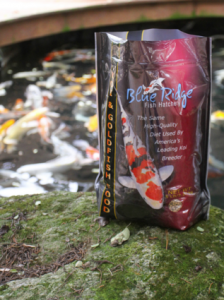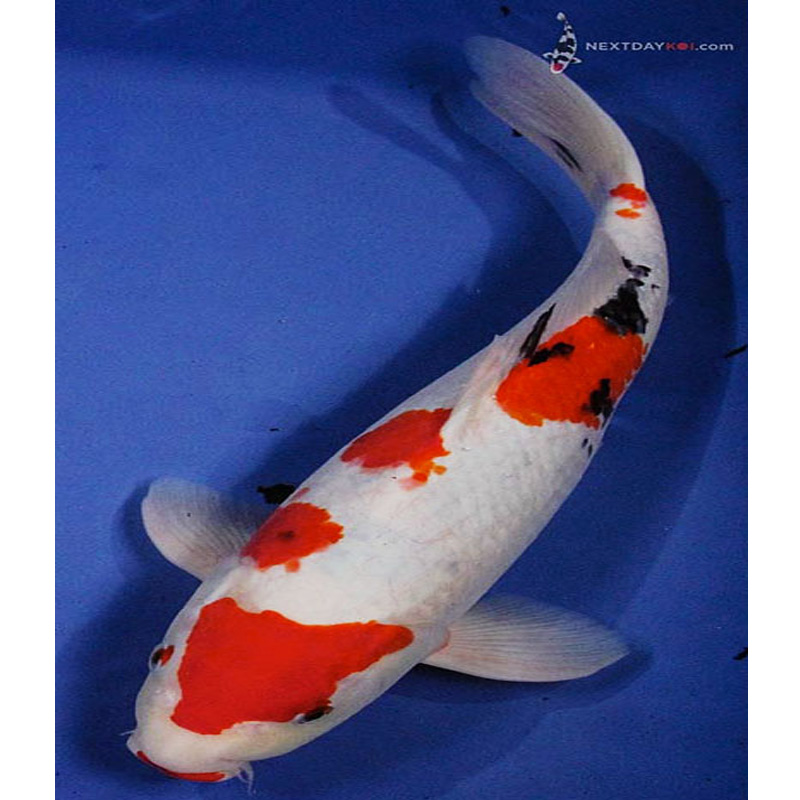Koi Fish Facts
Koi and Color Loss
Color loss. It’s a great source of concern (and irritation!) for many koi kichi. To see the colors for which this fish is famed lessen, change or disappear completely is not only saddening, but to some, maddening.
So why do koi lose their color? Perhaps it is important to look at where the colors come from first.
A Koi Gets its Colors
The simple answer is chromatophores. These pigment-containing cells are capable of reflecting and refracting light to give off the colors we see on our Nishikigoi. The chromatophore pigments are topped up by the foods that the koi eat. The better and more balanced the diet, the more abundant the pigment.
Chromatophores can also be in different parts of the epidermis and dermis (skin). They can be above and below the scales as well as deep in the skin. When the pigment lies closer to the surface, it is more likely to fade or spread out, making the color less intense. If the chromatophore is present in all parts of the skin, the chances of the color fading or thinning is much less.

A koi is born with all the chromatophores it will ever have. As the koi grow, the chromatophores will spread out, and can appear thin as they cover a larger area, and that is true for chromatophores on the skin’s surface.
Sadly, knowing if the chromatophores will be both stable and strong is an inexact science. However, if the parents had them, there’s a better chance the trait is handed down.
Koi have four types of chromatophores.
- Erythrin (red)
- Xanthin (yellow)
- Melanin (black)
- Lipochrome (orange)
All of the other colors that koi exhibit are a combination of these four types of pigment cells, while white is the absence of any chromatophores.
Because a chromatophore is branched, the color can move within the different “arms” of the cell. The more spread out the pigment, the better the color will be. The more concentrated in one area the color is, the less colorful that cell will be.
Chromatophores control the color, but another part of the cell (iridocytes) controls how reflective the colors will be. Iridocytes are light-reflecting guanine crystals. The closer to the surface the iridocytes are, the more reflective the scale will be. If they are deeper, the color takes on a more matte color.
Also the chromatophores that contain the red pigments are often likened to a leaky bucket. If the red pigment is not “topped up” it will continue to dribble out, getting weaker and weaker.
This article in smartkoi offers a deeper look at the science behind the coloration of koi.
Now that there’s an idea of how the colors are formed, we can look at how they are lost.
Causes of Color Loss
It is important to note that there is a factor, known as ontogenetic color change, that can naturally affect a koi’s coloration throughout its life cycle. It can have an effect on both the intensity and the pattern. This is a normal part of a koi’s development and not something that the owner can influence.
Water temperature

Believe it or not, the ambient water temperature can cause the pigments within the chromatophore to expand or contract. But unlike humans, warm water causes the color to concentrate in one area (weakening it). Cold water causes the pigment to spread (strengthening it). So koi look brighter in the winter months and less so in the summer. It is one of the reasons that Japanese shows are scheduled in the colder months of the year.
Water hardness or softness
Hard water (or water with higher concentrations of calcium and magnesium carbonates) is more alkaline with a higher pH and better for the black pigments. Soft water (with less mineral content) is more acidic. The lower pH value will cause the reds to spread, making them lustrous.
Food types
Your koi’s diet is important to, not just your koi’s overall health, but its color, too—even if you are not feeding with fortified color-enhancing food. High quality ingredients with the proper supplements will go a long way in helping a koi to put its best colors forward.
Age
 As a koi ages, its color (and even the pattern) can change. This is to be expected. As koi grow, the color cells are spread over a bigger surface area. Sometimes you just have to roll with it. Times (and your koi) are a-changin’.
As a koi ages, its color (and even the pattern) can change. This is to be expected. As koi grow, the color cells are spread over a bigger surface area. Sometimes you just have to roll with it. Times (and your koi) are a-changin’.
Some koi will naturally change in color throughout their lives. Most notably amongst the change artists is the Kumonryu. With age and changing water temperature, this koi will often shift colors, losing color or gaining more throughout its life.
Stress
The killer. Sometimes quite literally, but especially for color. A koi’s color is tied to its hormone and nervous system. As stress (or a stressful situation) will trigger both of those systems, a koi’s color will be affected by things like the response to predators, poor water quality or a sudden change in surroundings.
Breeding
The process of making little koi is one of extreme stress. Especially for the females who are chased, harangued and in some cases bruised into laying eggs for the males to fertilize. So she might not look her best after being badgered and made to lay eggs.
Salt
Remember that chromatophores are branched cells. The salt that is added to ponds to help against infections, or to help with slime coat production, causes the pigment to move to one area (concentrate), and this causes the color to weaken.
Antibiotics
The same as salt, antibiotics (injected or water-additive) will cause color concentration, which results in poor coloration. Malachite green will have the same effect.
Algae
Think au natural spirulina. Koi that snack on algae get a little pigment boost in the chromatophore and spread it around the cell, giving it a more intense color.
Ill health
When you’re feeling a little under the weather, you will take on a different color. Koi are no different in this regard. When they are ill they can take on a greyish hue. Keep an eye on your Living Jewels for such a color change, as it can help to more quickly nurse your koi back to health or prevent others from getting sick.
Genetics
This may come as no surprise, but if a koi comes from a set of parents that have deep colors, there is a better chance that it will inherit that trait.
The Sun
Koi can get sunburned! In the hottest part of the summer, it is possible that an uncovered or unshaded pond can lead to koi getting sunburned—even if the water is 8ft deep! If the sunburn is repetitive, it can result in ulcers which can affect the koi’s long-term coloration as well as its overall health.
Koi love sunny days and will come to the surface to enjoy the rays. If you don’t want additional reds and pinks on your koi’s back, you need to provide a little relief from the sun.
Here are some of the ways to help your koi avoid getting sunburned:
- Floating plants
- Floating metala pads
- Build a pergola with a lattice or a patio over part of the pond
- Shade or sail cloths
- Built in recesses for escaping direct sun (and predators!)
- Home-made floating islands
Ways to Enhance Koi Color
Good water parameters
We’ve said it before and we’ll say it again—good water parameters are the alpha and omega in koi keeping. The better the water, the happier and healthier your koi will be. A healthy koi by and large, will exhibit better coloration. Especially if they are getting the right amount of food as well as the right type of food. Which brings us to….
Color-enhancing food
The main ingredient in color-enhancing food is carotenoids. It is a substance found in the types of food that koi would encounter in the wild as part of their natural diet (such as snails, shrimp, krill and algae).
Carotenoids are important in boosting cellular pigmentation. Especially the reds. Spirulina is another food supplement additive that helps to boost the koi’s pigmentation.
 Too much of good thing, as they say, however. If color-enhancing food is overused it can negatively affect the white (shiro) of a koi, giving it a yellow or even greenish look. The whites may also take on a pinkish tinge from an excess of erythrin. The good news is that the colors return to normal once the color-enhancing food is removed.
Too much of good thing, as they say, however. If color-enhancing food is overused it can negatively affect the white (shiro) of a koi, giving it a yellow or even greenish look. The whites may also take on a pinkish tinge from an excess of erythrin. The good news is that the colors return to normal once the color-enhancing food is removed.
Feeding high protein color-enhancing foods is most productive and will yield the best results in the “peak growth” season (when water temperatures are over 60ºF).
Don’t scrimp on the quality either. The better the quality of food, the better and deeper the colors will be as a result.
Koianswers offers a great look at some of the natural alternatives that can help with koi colors, as well as some of the science behind how the colors are exhibited.
Of course, going through reputable, experienced dealers can go a long way toward helping you find a koi that has gone through a pretty intense vetting process. So with that, take a look at these hand-picked beauties.




